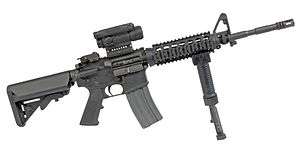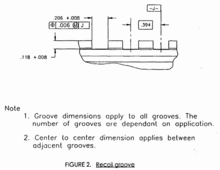Picatinny rail
The Picatinny rail (/ˈpɪkətɪni/ or /ˌpɪkəˈtɪni/), or Pic rail for short, also known as a MIL-STD-1913 rail or STANAG 2324 rail (canceled), is a military standard rail interface system that provides a mounting platform for firearm accessories. It was originally used for mounting scopes atop the receivers of larger caliber rifles. Once established, its use expanded to also attaching other accessories, such as: iron sights, tactical lights, laser aiming modules, night vision devices, reflex sights, foregrips, bipods, slings and bayonets.



Significance
Because of their many uses, Picatinny rails and accessories have replaced iron sights in the design of many firearms, and they are also on the undersides of semi-automatic pistol frames and grips.[1] Their usefulness has led to them being used in paintball and airsoft.[2]
History
The rail itself dates from work by the A.R.M.S. company in the early 1980s and Otto Repa in standardizing the Weaver design. Specifications for the M16A2E4 rifle and the M4E1 carbine received type classification generic in December 1994. These were the M16A2[3] and the M4[4] modified with new upper receivers where rails replaced hand guards.
The rail is named after the Picatinny Arsenal in New Jersey, which was tasked in 1992 to develop a standardized mounting system after the U.S. Army was dissatisfied with the contemporary products on the market. The Picatinny team was headed by mechanical designer Gary Houtsma (who was awarded the Order of Saint Maurice Award in 2014 for this contribution[5]), who took the measurements from 20 or so different Weaver rail products from weapons bunkers at Picatinny (and even sporting goods stores) and came up with an average set of numbers set on a 45-degree angled surface. Houtsma then took the specifications over to the production facility and requested they design a dimensioning style so the rail could be easily produced and inspected. The factory recognized the similarity of the purposed optics rail to the existing rail design on 105 mm howitzers, so they chose to scale down the howitzer rail design and co-opted the production and inspection procedures. The team then sent the finished product over to Rock Island Arsenal for review and trial, and then to the technical data section to determine if it should be a standard or a specification. After it was determined that the new rail should be a standard, not a specification, it was adopted and fielded in 1995[6] with the designation Mil-STD-1913, dated February 3, 1995.[7]
A metric upgraded version of the Picatinny rail, the STANAG 4694 NATO Accessory Rail, was designed in conjunction with weapon manufacturers like Aimpoint, Beretta, Colt, FN Herstal and Heckler & Koch, and was approved by the NATO Army Armaments Group (NAAG), Land Capability Group 1 Dismounted Soldier (LCG1-DS) on May 8, 2009.
Design & specifications

The rail consists of a strip undercut to form a "flattened T" or hexagonal cross-section provided with crosswise slots at intervals interspersed with flats that allow accessories to be slid into place from the end of the rail and then locked in place. It is similar in concept to the earlier commercial Weaver rail mount used to mount telescopic sights.
The Picatinny locking slot width is 0.206 in (5.23 mm). The spacing of slot centers is 0.394 in (10.01 mm) and the slot depth is 0.118 in (3.00 mm).[7]
Comparison to Weaver rail
Whereas the earlier Weaver rail is modified from a low, wide dovetail rail, the Picatinny rail has a more pronounced angular section. Designed to mount heavy sights of various kinds, a great variety of accessories and attachments are now available and the rails are no longer confined to the rear upper surface (receiver) of long arms but are either fitted to or machine milled into the upper, side or lower surfaces of all manner of weapons from crossbows to pistols and long arms up to and including anti-materiel rifles.
The only significant difference between the Picatinny rail and the similar Weaver rail are the size and shapes of the slots, where the Picatinny rail has square-bottomed slots while Weaver rails have rounded slots. This means that an accessory designed for a Weaver rail will fit onto a Picatinny rail whereas the opposite might not be possible (unless the slots in the Weaver rail are modified to have square bottoms.)
Weaver rails have a slot width of 0.180 in (4.57 mm), but are not necessarily consistent in the spacing of slot centers.[8] While some accessories are designed to fit on both Weaver and Picatinny rails, most Picatinny devices will not fit on Weaver rails. From May 2012, most mounting rails are cut to Picatinny standards. Many accessories can be secured to a rail with a single spring-loaded retaining pin.
See also
- NATO Accessory Rail
- Warsaw Pact rail, is a rail mount system to connect telescopic sights to rifles
- Rail Systems
- Zeiss rail, a ringless scope mounting standard
References
- "Does a Concealed Carry Gun Need an Accessory Rail? | Gun Belts Blog". Bigfoot Gun Belts. Retrieved December 19, 2018.
- "Magfed TCR". Tippmann Sports. Retrieved December 19, 2018.
- Pike, John. "M16 5.56mm Rifle". www.globalsecurity.org. Retrieved May 30, 2016.
- Pike, John. "M4 / M4A1 5.56mm Carbine". www.globalsecurity.org. Retrieved May 30, 2016.
- "Picatinny engineer recognized for developing venerable Picatinny Rail". U.S. Army. November 6, 2014.
- Guthrie, J. (September 23, 2010). "Rail Crazy: Picatinny Rail Basics". Shooting Times.
- "Dimensioning of accessory mounting rail for small arms weapons" (PDF). Archived from the original (PDF) on November 26, 2010.
- Brownells